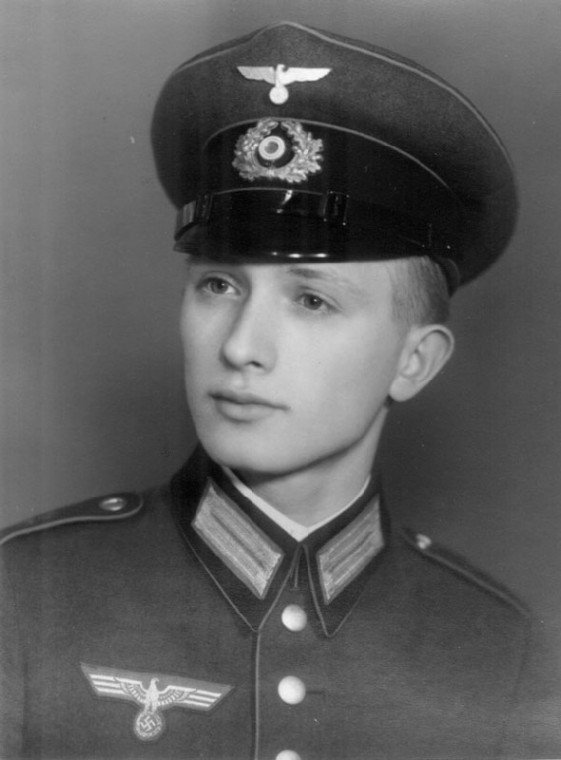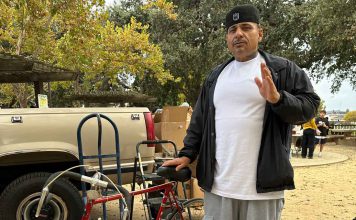By a burning barrel years ago, I accidentally stumbled upon an
important history lesson. I was about 12 or 13 when I made the
discovery that grey overcast Saturday morning.
By a burning barrel years ago, I accidentally stumbled upon an important history lesson. I was about 12 or 13 when I made the discovery that grey overcast Saturday morning.
One of my weekend chores was to burn trash in a large, rusty metal drum behind our Hollister home on top of Park Hill. Usually, I just pretty much chucked the garbage into the barrel’s blaze. For some reason, though, I opened up the Nob Hill paper bag. Scattered inside among the crushed milk cartons and rotting banana peels I noticed about 40 snapshot photos – black and white glossies – all curled slightly.
Curious, I pulled out the pictures and examined them closely. The images showed handsome young Teutonic men wearing World War II-era German uniforms. The men were smiling, laughing and horsing around. Some smoked cigarettes. Some goofed off for the cameras as they stood next to annoyed-looking camels. Others showed the men shopping in North African bazaars. In several, the shirtless men splashed around in the cooling water of an oasis complete with background palm trees.
Immediately, I knew who had taken these photographs – my mother’s brother, Gerhard Drückler. He’d served in North Africa under General Erwin Rommel’s command. He’d died in battle and his body was buried somewhere in Libya.
The snapshots he took of his buddies showed young men taking time out to enjoy life. It showed a side of World War II rarely seen in history books because it presents a fact people ignore in every war. The photos showed these young German men – these “enemy” soldiers – as people. Humans.
This week, the world celebrated the 60th anniversary of the end of history’s costliest war in terms of lives and destruction of property. Victory in Europe Day came on May 8, 1945, with Germany’s surrender. Four days later, the Axis powers in Africa also gave up, ending the fruitless campaign waged on that continent by Adolph Hitler.
President Bush this week toured Europe and met with national leaders for the anniversary. And in Berlin, officials dedicated a new Holocaust memorial. It is a melancholy monument of 2,711 grave-stone slabs and concrete “tombs” covering an area of about two soccer fields. Designed by U.S. architect Peter Eisenman, it’s officially called “The Memorial to the Murdered Jews of Europe.”
Unfortunately, the opening of this monument ignores half the story of the Holocaust tragedy. As good as the intentions might have been in its construction, it shows we haven’t truly learned the lessons of World War II. We cherry-pick those moral platitudes that allow our consciences to feel comfortable with the wrongs of the past. But we close our eyes to the bigger and more complex picture.
Not only did 6 million Jewish people perish in the death camps. The Nazis also murdered an estimated 6 million non-Jews. The failure to recognize them too demeans all who died.
No doubt, it’s a mistake to forget or ignore the lessons of the Holocaust. But it’s a danger also to continue with the unproductive “guilt tripping” of the German people. That’s a lesson we failed to learn from the disastrous Treaty of Versailles in 1919 which set in motion the conditions leading to World War II.
We must now deal with the injustices of today’s world. We can’t afford the morbid luxury of dwelling on a painful past. History moves on. Healing of old wounds can only come through forgiveness and from letting go of any past hatred of our former enemies. We damn ourselves to a psychological hell when we continue demanding an endless self-flagellation from a nation for crimes committed 60 years go. Another key to healing is to see our enemies as human beings. And that brings us back to Gerhard.
My parents gave me the middle name of “Gerhard” to honor my uncle. So as a kid, I was always curious about him. My mom said he was an immensely popular fellow who loved joking around with friends. He was also studious and very athletic. He enjoyed camping trips into Germany’s beautiful forests.
Gerhard wanted to be a train engineer. He did not want to be a soldier. He didn’t want to kill people. But at age 18, Gerhard was drafted into the German Army. It was either that or a firing squad. Hitler didn’t give him much of a choice.
And somewhere in Libya, he died. I don’t know where or the cause, but I do know the news of his death devastated my mother. As a young girl, she adored her brother.
Perhaps my mother’s parents saw Gerhard’s death and all the destruction and killing caused by war. It led them to make a courageous decision that put their lives in mortal peril if the Nazis ever found out. My grandparents and another German family secretly hid a Jewish household in a Berlin basement. I’ll probably never find out the names of those people they saved from the horrors of a death camp. But it makes me feel proud my grandparents were two of the many Germans who chose to preserve life instead of destroy it.
Somewhere in the attic, I still have those fascinating pictures I saved from a Saturday morning trash fire. I never told my mom I’d found the snapshots because I’m sure she had her reasons – emotional ones certainly – to destroy them.
I’ll never know the names of my uncle’s army buddies. To me, their haunting images are more than just a curious artifact from a long-ago war. Their images present a powerful message: that our so-called “enemies” are human beings. They’re like us. They have dreams and ambitions and families and friends. They laugh, they cry, they bleed, and they die.
Until we understand this lesson, we’ll never truly create peace between all nations. Perhaps more than any concrete slab, this would be the most honorable way to remember the 55 million people who died in a war that ended 60 years ago this week.












